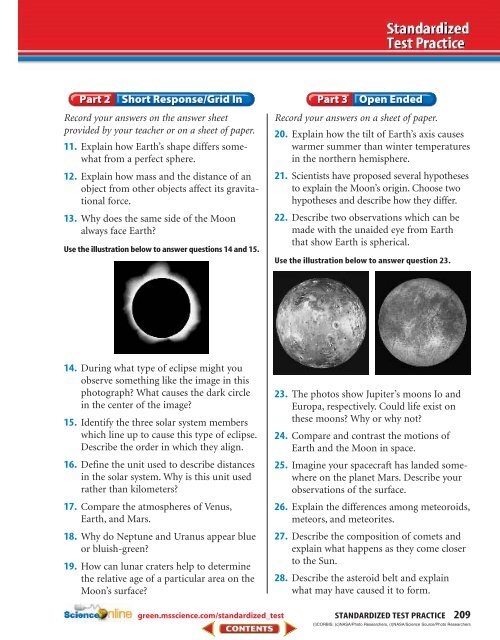Chapter 7: Earth in Space
Chapter 7: Earth in Space
Chapter 7: Earth in Space
You also want an ePaper? Increase the reach of your titles
YUMPU automatically turns print PDFs into web optimized ePapers that Google loves.
Record your answers on the answer sheet<br />
provided by your teacher or on a sheet of paper.<br />
11. Expla<strong>in</strong> how <strong>Earth</strong>’s shape differs somewhat<br />
from a perfect sphere.<br />
12. Expla<strong>in</strong> how mass and the distance of an<br />
object from other objects affect its gravitational<br />
force.<br />
13. Why does the same side of the Moon<br />
always face <strong>Earth</strong>?<br />
Use the illustration below to answer questions 14 and 15.<br />
14. Dur<strong>in</strong>g what type of eclipse might you<br />
observe someth<strong>in</strong>g like the image <strong>in</strong> this<br />
photograph? What causes the dark circle<br />
<strong>in</strong> the center of the image?<br />
15. Identify the three solar system members<br />
which l<strong>in</strong>e up to cause this type of eclipse.<br />
Describe the order <strong>in</strong> which they align.<br />
16. Def<strong>in</strong>e the unit used to describe distances<br />
<strong>in</strong> the solar system. Why is this unit used<br />
rather than kilometers?<br />
17. Compare the atmospheres of Venus,<br />
<strong>Earth</strong>, and Mars.<br />
18. Why do Neptune and Uranus appear blue<br />
or bluish-green?<br />
19. How can lunar craters help to determ<strong>in</strong>e<br />
the relative age of a particular area on the<br />
Moon’s surface?<br />
green.msscience.com/standardized_test<br />
Record your answers on a sheet of paper.<br />
20. Expla<strong>in</strong> how the tilt of <strong>Earth</strong>’s axis causes<br />
warmer summer than w<strong>in</strong>ter temperatures<br />
<strong>in</strong> the northern hemisphere.<br />
21. Scientists have proposed several hypotheses<br />
to expla<strong>in</strong> the Moon’s orig<strong>in</strong>. Choose two<br />
hypotheses and describe how they differ.<br />
22. Describe two observations which can be<br />
made with the unaided eye from <strong>Earth</strong><br />
that show <strong>Earth</strong> is spherical.<br />
Use the illustration below to answer question 23.<br />
23. The photos show Jupiter’s moons Io and<br />
Europa, respectively. Could life exist on<br />
these moons? Why or why not?<br />
24. Compare and contrast the motions of<br />
<strong>Earth</strong> and the Moon <strong>in</strong> space.<br />
25. Imag<strong>in</strong>e your spacecraft has landed somewhere<br />
on the planet Mars. Describe your<br />
observations of the surface.<br />
26. Expla<strong>in</strong> the differences among meteoroids,<br />
meteors, and meteorites.<br />
27. Describe the composition of comets and<br />
expla<strong>in</strong> what happens as they come closer<br />
to the Sun.<br />
28. Describe the asteroid belt and expla<strong>in</strong><br />
what may have caused it to form.<br />
STANDARDIZED TEST PRACTICE 209<br />
(l)CORBIS, (c)NASA/Photo Researchers, (r)NASA/Science Source/Photo Researchers

















